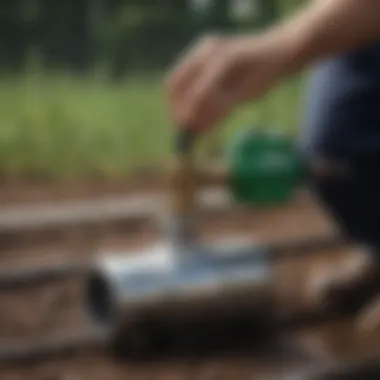Exploring the Benefits of Battery-Controlled Sprinkler Valves


Intro
As agriculture increasingly embraces technology, the integration of battery-controlled sprinkler valves stands out as a pivotal advancement. These valves represent a shift towards energy-efficient irrigation systems that can significantly enhance water management practices. Understanding the design, functionality, and advantages of these valves is essential for farmers and agricultural enthusiasts alike. This article aims to provide a thorough overview of battery-controlled sprinkler valves.
Key Concepts and Terminology
Definition of Terms
Battery-controlled sprinkler valves are automatic valves that regulate the flow of water in an irrigation system. These valves operate on battery power, which eliminates the need for electrical wiring. Key terms that are crucial to this topic include:
- Irrigation: The artificial application of water to soil.
- Sprinkler Valve: A mechanism that opens and closes based on control signals to manage water flow.
- Battery Power: The energy stored in batteries used to operate devices, like sprinkler valves, without reliance on the electrical grid.
- Flow Rate: The volume of water flowing through the system over a specific time period.
Overview of Relevant Practices
In contemporary agricultural practices, efficient water management is vital. Battery-controlled systems deliver water precisely when and where needed, reducing waste. These valves can be programmed or operated through remote controls, making them ideal for large farms or gardens with varying irrigation requirements.
Current Trends and Innovations
Latest Research and Developments
Recent studies have shown that battery-controlled valves can lead to significant water savings. Innovations in battery technology also allow these valves to operate for longer periods without recharging, increasing their efficiency. Research continues to explore smart technology integration for these systems, allowing for real-time monitoring and control.
Emerging Technologies and Tools
The rise of smart farming has led to the development of advanced tools that complement battery-controlled sprinkler valves. Wireless sensors can provide soil moisture levels, allowing for automated adjustments to irrigation schedules. These technologies work hand-in-hand to optimize water usage and enhance crop yields.
Practical Applications
Step-by-Step Guides
Implementing battery-controlled sprinkler valves in an irrigation system involves several steps:
- Assess Water Needs: Determine the specific water requirements for your crops.
- Select Valves: Choose the appropriate battery-controlled valves based on flow rate and pressure requirements.
- Install Valves: Properly install the valves in the irrigation system, ensuring all connections are secure.
- Program System: Set up the controls, programming the system for specific operating schedules of watering.
- Monitor Performance: Regularly check the performance of the valves to ensure optimal operation.
Troubleshooting Common Issues
While generally reliable, battery-controlled sprinkler valves can experience issues. Some common problems and solutions include:
- Valve Not Opening: Check the battery level and ensure it is correctly installed.
- Water Leakage: Inspect the valve seals and connections for wear or damage.
- Irregular Flow: Verify that the water supply is consistent and check for blockages.
"Battery-controlled sprinkler valves can transform traditional irrigation practices, leading to substantial improvements in efficiency and sustainability."
Understanding the functionality, benefits, and maintenance of these valves empowers farmers to make informed decisions. Overall, battery-controlled sprinkler valves present a compelling solution for modern irrigation challenges, marrying efficiency with practicality.
Prelims to Battery Controlled Sprinkler Valves
In the realm of modern agricultural practices, efficient irrigation stands as a cornerstone of successful crop production. Battery controlled sprinkler valves have emerged as pivotal components in achieving this efficiency. Understanding the nature and functionality of these systems is crucial for anyone involved in agriculture, from seasoned farmers to enthusiasts eager to enhance their irrigation tactics.
Battery controlled sprinkler valves utilize a battery-powered system to manage the delivery of water to crops. The operation of these valves allows for precision in water application, thus minimizing waste and addressing the challenges presented by inconsistent water resources. By integrating technology into the irrigation process, these systems provide the means for controlled and scalable water management, catering to a wide range of agricultural scenarios.
Importance of Battery Controlled Sprinkler Valves
The integration of battery controlled sprinkler valves into irrigation systems brings several specific benefits.
- Precision Management: These valves can precisely control when and how much water is distributed, leading to improved crop health and yield. This precision is a result of advancements in irrigation technology paired with user-friendly automation.
- Cost Efficient: With reduced water usage, these systems can lead to lower utility bills and better resource allocation, making them cost-effective in the long run.
- Versatile Application: These valves can be adapted to various systems, whether for small gardens or expansive farming fields, making them suitable for diverse agricultural settings.
Additionally, it is important for users to consider factors such as battery life, valve durability, and compatibility with existing systems when opting for battery controlled solutions. Understanding these aspects can ensure effective installation, operation, and maintenance of these systems.
"Understanding and leveraging battery controlled sprinkler valves is a significant step forward in irrigation technology, promoting both efficiency and sustainability."
For further reading, consider visiting: Wikipedia, Britannica, Reddit, Facebook.
Definition and Functionality


Understanding battery-controlled sprinkler valves involves examining the critical components that define their operation and functionality. Battery-controlled sprinkler valves represent a shift in irrigation technology, offering unique solutions to age-old problems. The relevance of defining what these valves are cannot be overstated, as they form the backbone of more efficient water management in agricultural practices today.
What is a Battery Controlled Sprinkler Valve?
A battery-controlled sprinkler valve is an irrigation device that uses a battery for its operation instead of relying on conventional electrical sources. This system allows for greater flexibility and ease of installation. Farmers can deploy these valves in remote areas without accessible power supply, providing fresh and efficient irrigation technology.
The defining feature is that these valves can be controlled independently of a central control system. They manage the flow of water automatically, responding to preset schedules or conditions. This autonomy adds to their increasing popularity and relevance in various settings like agriculture and landscaping.
How the System Works
To appreciate the utility of battery-controlled sprinkler valves, one must dive into their operational intricacies. Two critical aspects form the essence of their functionality: the electrical components and the water flow mechanics.
Electrical Components
Electrical components play a vital role in battery-controlled sprinkler valves, allowing for efficient operation. The heart of the system is often a solenoid, which opens or closes the valve based on the electrical signals it receives. These components are chosen for their reliability and low power consumption, ensuring that the system can run efficiently for extended periods.
A key characteristic of these components is their simplicity. They require minimal wiring, making installation straightforward. Users can set them up without requiring advanced technical knowledge. This accessibility is one of the many reasons battery-controlled systems have become an attractive option for farmers and landscapers alike.
However, it is essential to consider that the lifespan of these electrical components is generally reliant on the batteries used. If the battery depletes, the system stops functioning until it is replaced or recharged. Thus, while battery systems offer considerable advantages, they require a commitment to routine maintenance.
Water Flow Mechanics
Water flow mechanics represent the practical application of the valve's design and components. The valve operates by controlling the water pressure and flow rate supplied to irrigation zones. When the solenoid is activated, it opens the valve, allowing water to flow through the system.
A notable feature of water flow mechanics is that they can be adjusted. By altering the settings or choosing different nozzles, users can customize the flow of water according to the specific needs of their crops or landscape. This flexibility contributes significantly to water efficiency.
However, improper maintenance or adjustments can lead to issues such as over or under-watering, which can adversely affect plant health. Therefore, understanding the mechanics of water flow in context with the overall irrigation strategy is crucial for effective water management in agriculture.
Understanding these fundamental components and their roles provides insight into why battery-controlled sprinkler valves are crucial for modern irrigation. They offer not just operational flexibility, but also the ability to conserve water effectively.
Advantages of Battery Controlled Systems
Battery-controlled sprinkler valves present distinct advantages that significantly enhance irrigation systems. These benefits can transform how water is managed in agriculture. Their design focuses on efficiency and sustainability, which align with modern farming practices aimed at conserving resources. Below, we will explore some of the primary advantages associated with these systems.
Energy Efficiency
One of the standout features of battery-controlled systems is energy efficiency. Unlike traditional sprinkler valves that rely on continuous power sources, battery-operated valves function independently. This reduces the overall energy consumption of the irrigation system. With advancements in battery technology, newer batteries offer longer life and improved performance. By harnessing energy efficiently, farmers lower their operational costs. They can allocate saved resources to other critical areas of their farms. This sustainable approach contributes to reducing emissions tied to energy production, further promoting environmental stewardship.
Cost-Effectiveness
Implementing battery-controlled sprinkler valves can be a financially smart decision. Initial installation costs might be on par with traditional systems, but long-term savings are evident. Battery systems often require less frequent maintenance. This translates to lower labor costs over time. Additionally, the decreased energy needs further cut expenses related to electricity. Farmers can invest in more productive technology, ensuring they get the best return on their investment.
A careful evaluation can show how these systems protect the budget while still delivering effective irrigation solutions.
Reduced Water Waste
Water conservation is becoming increasingly vital amid global water shortages. Battery-controlled sprinkler valves help minimize water waste through precise control. These valves can operate on predetermined schedules and adjust to environmental factors. For example, with rain sensors, the system can delay watering. This functionality prevents over-irrigation. By ensuring water is used only when necessary, farmers contribute to sustainable practices.
"Water-efficient practices are the cornerstone of modern agriculture, ensuring not just crops thrive, but resources are preserved for future generations."
In summary, battery-controlled sprinkler valves stand out in terms of efficiency, cost savings, and environmental impact. They are pivotal in modernizing how water management is approached in agriculture.
Comparison with Traditional Sprinkler Valves
When evaluating battery-controlled sprinkler valves, it is essential to understand how they compare to traditional sprinkler systems. This comparison highlights the advances in irrigation technology and the reasons for transitioning to newer systems. Not only do battery-controlled systems provide innovative functionality, but they also address the limitations commonly associated with traditional methods.
Control Mechanisms
Traditional sprinkler valves typically rely on pressure-sensitive systems or manual operation. These mechanisms can lead to inefficiencies as they may not adapt to changing conditions well. In contrast, battery-controlled valves often employ smart technology that allows them to be programmed or remotely controlled. This means users can adjust their watering schedules directly from a smartphone or a centralized control panel.
- More Effective Watering: The programmable nature helps in delivering precise amounts of water based on environmental factors.
- Sensors and Feedback: Newer systems can include sensors that monitor soil moisture and weather, allowing the sprinkler to operate only when necessary.
Maintenance Requirements
The maintenance regimen for battery-controlled systems can often be less demanding than that of traditional valves. Traditional systems may require frequent manual checks and adjustments, making them susceptible to clogs and mechanical failures. Battery-controlled valves, however, are usually designed for longevity and reduced upkeep.


- Less Frequent Repairs: Improved materials and engineering reduce the impact of wear and tear.
- Remote Diagnostics: Some modern valves come equipped with diagnostic features that notify the user of issues right away.
Installation Process
Installation of battery-controlled sprinkler valves is often seen as more straightforward compared to traditional options. Traditional systems can require extensive rewiring and professional installation due to their complexity. On the other hand, many battery-controlled valves are designed for ease of installation, often allowing farmers or enthusiasts to perform the installation independently.
- Simplified Wiring: With fewer wiring needs, installation can often be completed with basic tools.
- Modular Components: Many battery-controlled systems offer modular parts, allowing users to adapt their setups as needed without a complete overhaul.
Overall, comparing battery-controlled sprinkler valves to traditional systems showcases significant improvements in control, maintenance, and installation. These innovations pave the way for more efficient water management practices crucial in agriculture today.
Applications in Agriculture and Horticulture
Battery-controlled sprinkler valves play a significant role in modern irrigation systems, making them essential for agricultural and horticultural practices. These valves are designed to enhance efficiency, providing precise control over water distribution in various settings. Understanding their applications in these fields is crucial for farmers and horticulturists seeking to optimize water management strategies.
Field Irrigation
In field irrigation, battery-controlled sprinkler valves offer a dependable solution for applying water uniformly across agricultural crops. The ability to control water flow and timing accurately means farmers can reduce water wastage while ensuring plants receive adequate moisture. The customizable settings of these valves enable farmers to cater their irrigation schedules based on crop needs and environmental factors, such as rainfall.
Utilizing battery-powered systems can result in significant labor savings and reduced operational costs. Moreover, these valves can function effectively without a constant power supply, which is beneficial in remote or off-grid locations.
Greenhouse Management
In the context of greenhouse management, battery-controlled sprinkler valves are invaluable. They can create specific irrigation cycles that suit various plant species, using controlled microclimates to promote optimal growth. By adjusting water delivery precisely, growers can prevent overwatering, which often leads to root rot and other moisture-related issues.
Additionally, these valves support integration with environmental sensors, enabling real-time adjustments based on internal humidity and temperature levels. This responsiveness results in an efficient system that maximizes both plant health and resource use.
Landscape Design
Battery-controlled sprinkler valves are also highly beneficial in landscape design. They allow for the creation of diverse irrigation zones that can cater to different plant types and layouts. Landscapes often have areas requiring more water due to sun exposure or specific plant water needs; battery-controlled valves can manage these zones effectively.
Using these valves also encourages sustainable practices by ensuring that water is applied strategically, therefore reducing runoff and evaporation. This technology not only enhances the aesthetic appeal of gardens and parks but also conserves water, aligning with environmental goals.
"Battery-controlled systems provide flexibility and precision in irrigation—key factors for sustainable agriculture and landscaping."
In summary, battery-controlled sprinkler valves provide a range of applications in agriculture and horticulture. From enhancing field irrigation to optimizing greenhouse environments and landscape layouts, their adaptability presents an opportunity for improving water management practices. By integrating these systems, farmers and horticulturists can achieve greater efficiency and sustainability.
Key Features to Consider
When selecting battery-controlled sprinkler valves, certain key features must be thoroughly analyzed. Understanding these aspects ensures proper functionality and optimal performance within the irrigation system. Key features can directly affect the system's efficiency in water conservation and overall effectiveness in agricultural applications.
Valve Size and Compatibility
Valve size is crucial for the proper functioning of a battery-controlled sprinkler valve. The right size ensures that water flows correctly and efficiently throughout the irrigation system. An improperly sized valve can lead to pressure loss or inadequate coverage. Furthermore, compatibility with existing irrigation components aids in seamless integration, preventing future complications.
When assessing valve size, it is essential to consider the flow rate requirements for specific crops or landscape designs. Not all applications will have the same need for water delivery. Therefore, consulting manufacturer specifications is wise to make the most informed decision.
Durability and Material
The durability of battery-controlled sprinkler valves largely depends on the materials used in their construction. valves made from high-quality and resilient materials can withstand various environmental conditions, such as extreme temperatures, exposure to UV rays, and potential corrosive substances found in water sources.
Common materials include PVC, brass, and stainless steel, each offering unique benefits. For example, PVC is lightweight and resistant to corrosion, but brass provides superior strength and longevity. Selecting the most suitable material relates to the specific conditions under which the valve will operate.
Battery Life and Performance
Battery life and performance are fundamental when considering battery-controlled systems. A valve powered by a high-performance battery can operate for longer periods without interruption. Understanding the energy consumption of the valve can help farmers determine the type of battery needed for optimal performance.
It is advisable to choose valves that offer easy access to the battery compartment for swift replacements or upgrades. Additionally, some modern systems feature indicators that notify the user when the battery level is low, ensuring that irrigation needs are met without delay.
"Choosing the right battery-controlled valve not only enhances irrigation efficiency but also plays a crucial role in preserving water resources in agriculture."
By focusing on these specific features, farmers and irrigation enthusiasts can ensure they select the right battery-controlled sprinkler valves suitable for their unique agricultural practices.
Maintenance and Troubleshooting
Maintenance and troubleshooting are essential components in maximizing the performance and longevity of battery-controlled sprinkler valves. Regular upkeep ensures that the system operates efficiently and effectively, preventing waste and downtime. Farmers and horticulturists should prioritize these activities to guard against unexpected failures, promote the overall health of their irrigation systems, and enhance water management practices.


Routine Checks
Implementing a routine check of battery-controlled sprinkler valves is crucial for smooth operation. Here are some specific areas to focus on:
- Battery Inspection: Check the battery's charge level periodically. A weak battery can impair the sprinkler's functionality, leading to inadequate water distribution.
- Valve Operation: Test the valve opening and closing functions to ensure they respond to commands without delay. Any issues in this domain may suggest internal mechanical problems or electrical failures.
- Connection Integrity: Examine electrical connections for signs of wear or corrosion. Poor connections can lead to intermittent functionality or complete failures. Addressing connection issues early on can save time and money.
- Physical Condition: Inspect the valve body for any visible damage, leakage, or sediment buildup that could hinder performance. Cleaning these components regularly will promote a healthy water flow.
Incorporating these checks into a weekly or monthly maintenance schedule can help mitigate serious issues before they arise.
Common Issues and Solutions
Despite thorough maintenance, some common issues may still occur with battery-controlled sprinkler valves. Understanding these problems and their solutions is vital for efficient troubleshooting:
- Issue: Inconsistent Water Flow
- Issue: Valve Won't Open or Close
- Issue: Frequent Battery Replacement
- Issue: Leaking Valves
- Solution: Check battery charge, clean the valve, and inspect for blockages in hoses. If the problem persists, consider replacing the valve.
- Solution: Inspect the battery and electrical components for faults. A damaged wire or poor connection may prevent operation. Repair or replace as necessary.
- Solution: Investigate power consumption. If the valve is using excessive energy, there may be a fault or wear in components.
- Solution: Check seals for wear and tear. Replace any damaged washers or O-rings to eliminate leaks. Regularly inspect these components to prevent future leakage.
"Preventative maintenance is key to extending the lifespan of your equipment and reducing costs associated with repairs and replacements."
By recognizing these challenges and employing effective solutions, users can ensure their battery-controlled sprinkler valves operate at optimal efficiency, leading to enhanced agricultural productivity.
Future Trends and Innovations in Sprinkler Technology
The landscape of irrigation technology is evolving. As water scarcity becomes a pressing global issue, optimizing water use in agriculture is increasingly vital. Battery-controlled sprinkler valves are at the forefront of this change. They enhance efficiency, reduce waste, and offer flexibility in diverse agricultural settings.
Smart Water Management Systems
Smart water management systems signify a transformative step in irrigation practices. These systems leverage data-driven strategies to optimize water use. Sensors monitor soil moisture levels, weather patterns, and crop needs, allowing for precise watering schedules. Through real-time adjustments, these systems ensure that crops receive exactly what they need, neither too much nor too little water.
With integrated software, farmers can access this data from mobile devices. This ease of access supports informed decision-making. The technology helps in planning irrigation based on not only the immediate requirements but also predictive analytics for future needs. This proactive approach is essential in maintaining the health of crops and optimizing resource use.
- Benefits of Smart Water Management Systems:
- Accurate irrigation based on data
- Reduced water wastage
- Enhanced crop health
Integration with IoT
The Internet of Things (IoT) brings an additional layer of sophistication to sprinkler valve technology. By connecting battery-controlled sprinkler valves to the IoT, farmers can create a comprehensive irrigation network. This integration allows for constant communication between devices, providing detailed insights into the irrigation process.
For instance, IoT-enabled sensors can notify users if there's a malfunction in the system or if watering is required. This connectivity reduces the risk of human error and boosts system reliability. Farmers can receive alerts directly on their phones, facilitating immediate actions that address issues without delay.
Moreover, analyzing data accumulated over time can lead to better irrigation strategies. Patterns in water usage can emerge, allowing farmers to adjust operations for maximum efficiency.
"With IoT integration, we take a step closer to fully automated irrigation systems that are responsive and efficient."
- Considerations for IoT Integration:
- Ensure strong network coverage in agricultural fields
- Regular software updates for devices
- Training for users to navigate the technology
The convergence of battery-controlled sprinkler valves with smart water management systems and IoT technologies represents a significant shift in how irrigation is approached in agriculture. Embracing these innovations can lead to sustainable practices that benefit the environment and reduce operational costs.
Finale
Understanding battery-controlled sprinkler valves is essential in today’s irrigation practices. They bring significant advancements over traditional systems, especially in terms of efficiency and management. With water scarcity becoming a pressing issue globally, optimizing irrigation through these valves can lead to better conservation of this vital resource.
Summary of Key Points
- Efficient Water Management: Battery-controlled systems save water by allowing precise control over irrigation cycles. This reduces waste and ensures that crops receive the necessary moisture in a timely manner.
- Cost-Effective Solutions: Although the initial investment may be higher, battery-operated valves often lead to lower operational costs. Longer-lasting performance and reduced maintenance contribute to overall savings.
- Technological Integration: These valves can easily integrate with modern irrigation technologies, like smart sensors and IoT devices, enhancing their usability and performance.
- User-Friendly Maintenance: Regular checks and straightforward troubleshooting methods keep these systems running efficiently. Farmers find that the ease of maintenance encourages more consistent use and monitoring.
Final Thoughts
In summary, battery-controlled sprinkler valves represent a forward-thinking approach to irrigation. Their ability to enhance water efficiency, lower costs, and integrate with smart technologies places them at the forefront of agricultural innovation. As challenges in water management continue to grow, these systems are not just preferable; they are becoming necessary for sustainable farming practices. Those who adopt this technology will not only benefit their operations but also contribute positively to global water conservation efforts.
Battery-controlled sprinkler valves are not just a trend; they are a significant step towards smarter water management and sustainable agriculture.
Understanding these systems equips farmers and agricultural enthusiasts with the knowledge to make informed decisions that support long-term success and environmental responsibility.







